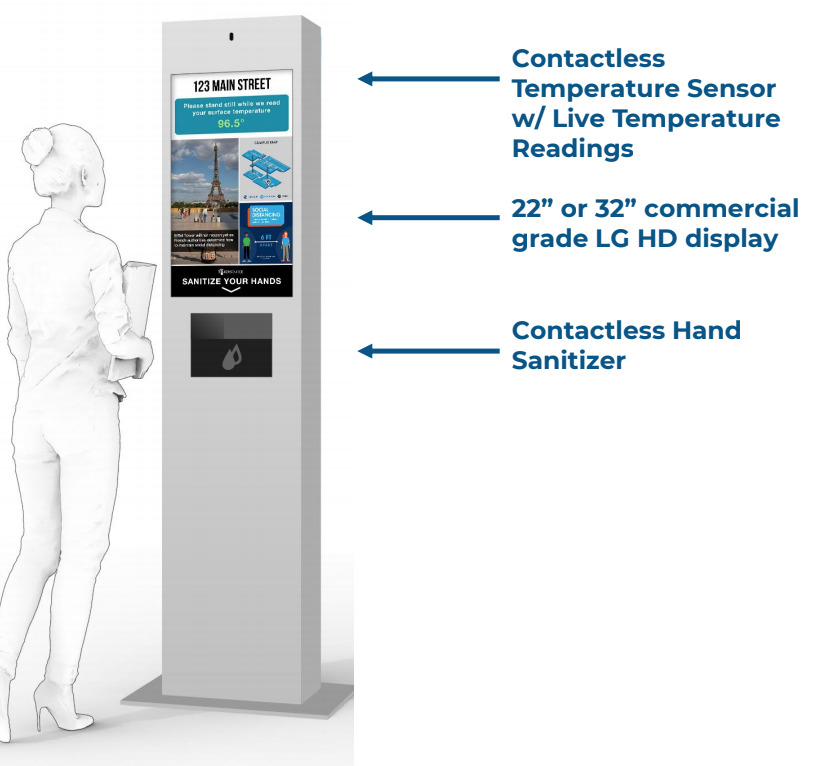Covid-19 has dramatically changed consumer behavior, as well as their day-to-day living. Required temperature checks have become common in many places, especially in healthcare environments. Today, we will discuss temperature check kiosks, detailing how they operate and why they are useful during COVID-19, and will remain so even once the worse of the pandemic is behind us.
What is a temperature kiosk?
A temperature kiosk is used to quickly, and without contact, scan users’ temperatures. This gives organizations the ability to screen individuals for one of the most common symptoms of COVID-19, as well as other illnesses, such as seasonal influenza. If an abnormal temperature is found, it allows the user to be separated from others before they are able to potentially infect them, until they undergo additional screening and can then be either sent home, or allowed to enter the premises.

Why are temperature kiosks still important?
Despite the development and rapid deployment of the COVID-19 vaccine to many areas of the world, it remains a serious threat to public health, especially in states or cities with low vaccination rates, and in environments with high numbers of elderly people or those with pre-existing medical conditions that may make them more susceptible to illness. By mid-2021, an estimated 250 million people had been infected worldwide with as many as 2 million deaths recorded. With new, more easily transmissible and deadly variants becoming the dominant virus strains in most countries, and much of the world still unvaccinated, it is likely that the spread of COVID won’t truly slow down until well into 2022, and possibly even 2023, according to a recent McKinsey article.
It is for this reason that temperature kiosks will remain an important tool for providing quick, contactless health screenings for the foreseeable future. The kiosks help provide a basic safety net for visitors to, and guests and employees of, any organization that works with the public.
Which industries should consider temperature check kiosks?
Below are industries that would greatly benefit from the implementation of temperature kiosks. These are industries that see heavy foot traffic and need a quick and hassle-free method of screening guests, visitors and staff.
- Construction and property development
- Theme parks and museums
- Entertainment venues (stadiums, arenas, concert halls)
What features should a temperature kiosk have?
Temperature kiosks are comprised of several important components:
- Software: The software functions as the brain of the kiosk, allowing it to accurately read, record and report data from the contactless temperature scanner. Additionally, the software provides a user-friendly interface that is easy to operate.
- Temperature sensor: Temperature kiosks employ infrared thermometers to provide an accurate reading of a user’s body temperature. These thermometers work in conjunction with the software to provide a quick and accurate reading on the kiosk’s display.
- Display/Screen: The kiosk’s display allows the user to see his or her temperature reading clearly. The display works in conjunction with the software to provide accurate readings that can quickly be identified as abnormal, and potentially a public health issue.
- Hand sanitizer: Lastly, many kiosks include hand sanitizer dispensers to give users the opportunity to sanitize their hands before entering the premises. The hand sanitizer is generally provided via a contactless dispenser that utilizes a motion sensor to detect a user’s presence.
How do temperature check kiosks work?
Temperature screening kiosks are remarkably easy to install and use, while remaining quite powerful as a screening tool to help create safer environments for users. Here’s how these kiosks work:
- User faces the temperature kiosk: The user stands at an appropriate distance from the infrared scanner. If they are not facing the appropriate direction or they are standing too far away, the scanner will not scan them.
- Kiosk scans the user for their temperature: Once standing at an appropriate distance, the kiosk utilizes a contactless infrared thermometer to scan the user’s body temperature.
- Temperature is displayed: Once scanned, the user’s temperature is displayed on the digital display. Most kiosks’ software can be customized with alerts for specific temperature ranges, in order to accurately flag those considered abnormal.
- User is flagged or not flagged based on outcome: If the recorded temperature scan is above (or or even below) the set temperature range, the user is flagged for additional screening. If no fever is present, the kiosk directs the user to utilize the sanitizer, then resets to be ready for the next guest.
Covid-19 has greatly impacted public health, shifting how the world operates. Temperature check kiosks help by providing an additional layer of screening for potential illnesses. Although they may be simple, these kiosks are instrumental in protecting individuals’ health and wellness now, and into the future.

